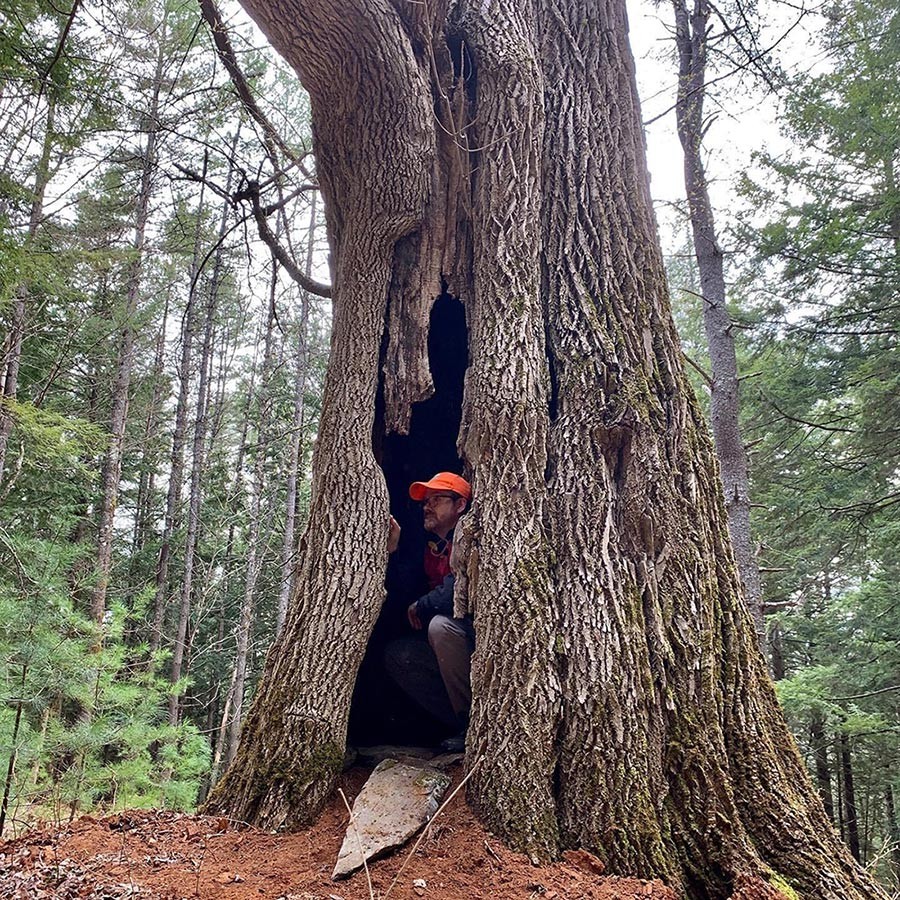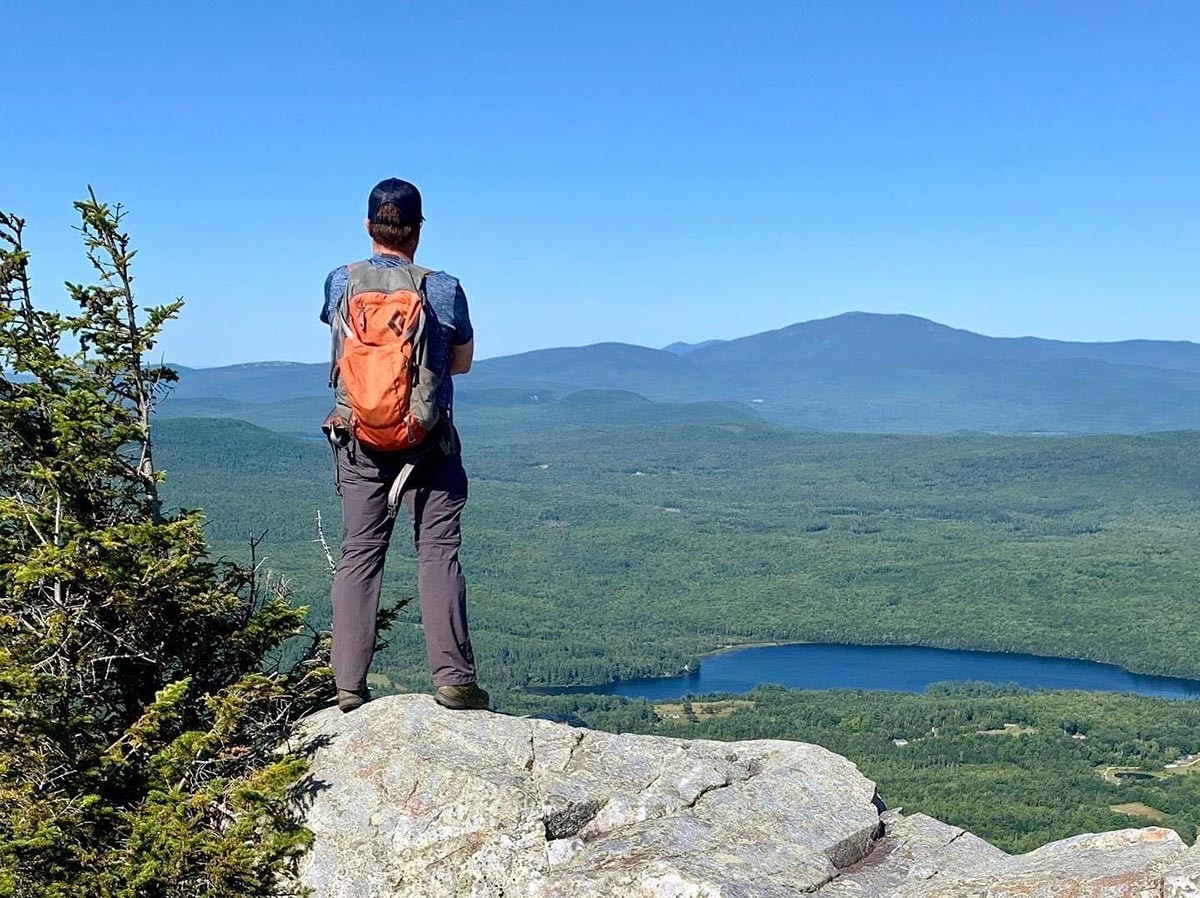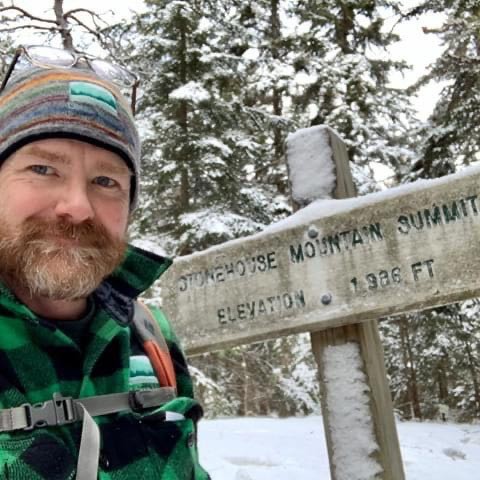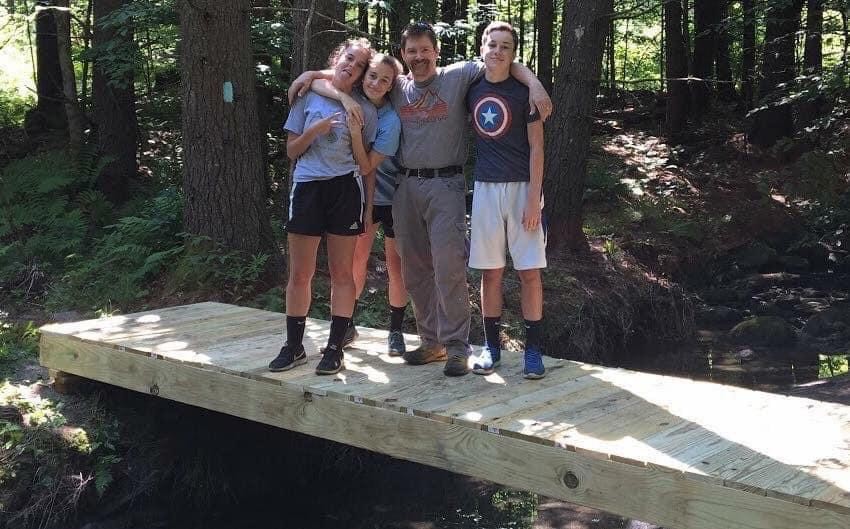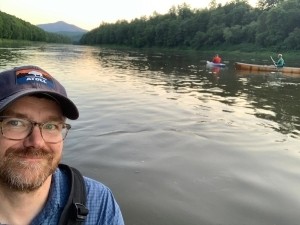
Jason Berard grew up in Vermont’s Northeast Kingdom. He and his wife moved from Boston to the Upper Valley two decades ago and have raised their three children – all now teenagers – in a 1780 cape house. For the past decade, he’s worked for Upper Valley Land Trust, first as a land steward and for the past six years as Stewardship Director. Beyond monitoring easements, Jason puts in many volunteer hours helping to maintain the Appalachian Trail Corridor, and he’s currently restoring a 1928 Old Town OTCA canoe.
My family has lived in Vermont since before it was a state, but I grew up moving around a lot while my dad was in the Navy. In 1977, we moved to St. Johnsbury after he completed his military service. Growing up in St. J, I spent equal parts of my childhood in the Fairbanks Museum, the St. Johnsbury Athenaeum, and just roaming the surrounding woods with friends. I loved to be outside walking our dog, Sheila, stream fishing for trout in Bean Brook in Newark, and trolling for bass in Moore Reservoir.
All of those – inside places like the Athenaeum and the Museum, as well as the outside places – were places where innate curiosity could rule, and I was free to let one thought or question flow organically into the next. I guess I was “forest bathing” before I had ever heard of the term! This is still how I relate to the natural world. It is a place to wander, to wonder, to learn from and to let the land tell me where to go next, literally and metaphorically. These experiences also taught me that a place did not have to be particularly large or wild to allow one to meaningfully connect with nature.
Working on the Appalachian Trail was what led to the opportunity for me to work at Upper Valley Land Trust. When our kids were little, I started working from home. I’m an extrovert, and that felt kind of isolating to me. My solution was to start doing a bunch of volunteer work for the Dartmouth Outing Club on the AT. I would bring my kids with me and we would just go out and clear trails and blaze trails. It was a tremendous amount of fun. And it really felt like a good way to teach my kids about stewardship and the fact that there are all these amazing recreational resources, and how much effort it takes to establish those and maintain them over time.
At that time, the Dartmouth Outing Club was responsible for 75 miles of the AT, from Woodstock, Vermont, to Woodstock, New Hampshire. At first, I was a trail maintainer. Then I coordinated the volunteers who helped maintain the trails. Then I started doing AT corridor work, which is kind of like a giant treasure hunt. You’re walking along this corridor of land that the AT is within, and it’s federally protected. There’s a survey of this land, and the corridor monitor and maintainer’s job is to follow that survey and find the monuments that are located about every 500 feet along the corridor. My favorite thing is reclaiming old corridor. The blazes that define that boundary are faded. You’ve got to work hard to find those. You’ve got to dig for the monuments. It’s as much personal enjoyment for me as it is stewardship. Eventually, I started coordinating the volunteers that do that work for DOC. That work is very similar to monitoring a conservation easement – checking for encroachments from outside to inside the corridor, being able to navigate through the woods off trail.
My first introduction to UVLT was when we were trying to move back from the Boston area, and we were looking for a place to buy. We were just transfixed by this house in North Thetford. It still had all of the features that make people like old houses. It’s across from a hayfield that has a great view of Smarts Mountain. We’d heard a rumor that the land was conserved, and at that point I didn’t even know what that meant. We wanted to know if anyone could build a house in the hayfield and block our view. It turned out that the land on three sides of the house, which we bought, is conserved through Upper Valley Land Trust. Eleven years later I started working at the land trust.
On the stewardship side of the office, we need to know a little bit about a lot of things: forestry, agriculture, ecology, map-making, navigation, carpentry, trail building, conflict resolution, charitable trust regulations, and I’m sure more areas that I’m forgetting. But I’m not necessarily an expert in any of these areas. One of the great privileges of this work is to meet the people who are experts in these fields and to learn from them, and share that knowledge with others.
We work in 45 towns. We have 54,000 acres conserved – with over 200 miles of trails – and 6,000 acres of that is land we own. Owning land in both states helps us advocate for policy decisions in each state. The three of us at UVLT who are in stewardship, we all do fee land management, and we all do conservation easement monitoring. We’re then able to speak to our landowners as peers. We understand the challenges of making land management decisions.
The projects that we are working on right now that I find the most rewarding have a common theme of making land conservation meaningful to the whole community. Whether that is a pocket park in a densely settled neighborhood, or growing food for folks experiencing food insecurity, or providing firewood for heating assistance programs in our region when we conduct a timber harvest.
For me, the enjoyment of each property is so tied up in the relationships that I have with the people that also love or have loved these places. The longer I do this work, the more of those people are now gone. In a way, stewardship is holding those voices and stories in your memory, and doing your best to ensure that their memory and legacy continue into the future – until I also become one of those voices in someone else’s memory, I suppose, if I am lucky! Right now, if I had to pick, I’d say that my favorite place to go is to paddle along the Connecticut River. It is the central landscape feature that unites our work, and I’ve spent more time on the river this year than ever before.
There’s clearly been an increase in the numbers of people seeking outdoor recreation this summer. None of our conservation areas are getting anywhere near the usage that places like the White Mountain National Forest are experiencing, but we are seeing more use, especially along the Connecticut River. The Connecticut River Paddling Trail, which goes from source to sea, includes 10 campsites through the Upper Valley that UVLT maintains. A major user of those sites are summer camps, and all of those are on hold this year. But we’re still seeing a massive uptick in the usage of the campsites. I think it’s more local residents. It does seem to me that people are looking for places in their backyard that they can go. And we’ve got those. We’ve also noticed a tremendous increase in interest in helping to steward those resources and maintain trails.
I think the biggest challenge when it comes to forest health is that we, as a society, have a long list of things that we are asking from our forests, from timber harvests and wildlife habitat management to recreation. Managing a property, let alone a regional landscape with all of these needs and goals, is a major challenge for landowners and policy makers, and favoring any one objective can have impacts on the others. It’s important to acknowledge that we’re all making the best land management decisions we can with the information we have right now, and that those decisions may change as we learn more. From a forestry perspective, I’ve walked some properties recently with landowners who have long histories of careful land management, and the thing I keep hearing is variations on “past experience does not predict future results.” It must be very hard to create a long-term management plan for a property when you’re not sure what the outcome from any particular treatment will be on a given site.
I’d say there is an evolving understanding that healthy forests do benefit us so much in all of the areas mentioned above. I think a much broader cross-section of the community now values forests, and that can only lead to more support for work to protect healthy intact forests now and into the future. On the stewardship side of the equation, one change in recent years is that potential buyers of conserved lands come to the process with more knowledge of what a conservation easement is, and they are actively seeking out conserved lands because they value the resources that the easement aims to protect.
My path has been absolutely the opposite of linear. Sometimes I feel like my avocation and my vocation are two completely overlapping circles in a Venn diagram. My undergraduate degree is in fine art, and I spent the first 20 years of my professional life as a picture framer and art restorer, and now I work in land conservation. But seeing that connection between art and nature, and sort of starting down one path of that exploration and then switching to the other – it makes sense to me. Nothing is life is really linear anyway. Certainly nothing in nature is.


